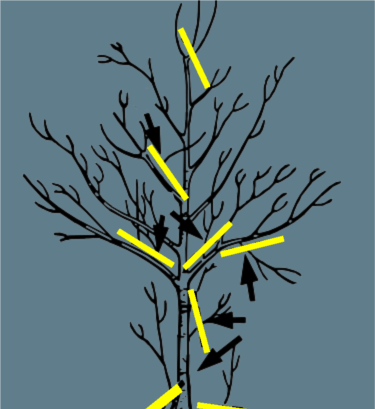Strengthening and accelerating the development of ornamental plants, healthy development of plants. to provide the desired form, to provide the amount and quality of flowering and fruit Pruning is done to increase it. Pruning; development of plants, strengthening, maintaining their healthy development, It is applied in ornamental plants in order to increase flowering, fruit quantity and quality. cutting, bending, bending, getting buds and shoots, adjusting the angle of the branches to the trunk such operations.
The Importance of Pruning in Ornamental Plants
In general, pruning is very important in the growth, development and yield of plants. has an important place. Pruning practices are primarily related to plant physiology and ecology. should be appropriate. In general, the purposes of pruning in ornamental plants are as follows: We can sort:
- Creating and maintaining physiological balance in ornamental plants in a short time.
- Remove branches that may fall from the tree, causing injury or property damage. remove.
- Removing branches that block the view of the roads from the tree.
- Dried, diseased, broken by ecological and mechanical effects, damaging each other and diagonally overlapping each other, protruding from below, head drooping down, out of symmetry, destabilizing the tree, weak, narrow angle cut branches.
- In order to increase carbon assimilation (assimilation) in plants, the use of light to allow better penetration into the inner parts of the trees and to clean the leaf surfaces. increase.
- By arranging the number and distribution of the main branches on the trunk, to ensure that they form a strong, regular and balanced crown.
- To give the plants a beautiful appearance by giving different shapes.
- Maintain a shape given to plants.
- To increase the flower yield and quality of plants.
Ornamental plants pruning time

The pruning time of ornamental plants may vary according to the species. for pruning Generally, plants are in a dormant state and in the ability to develop under certain conditions. Pruning times should be determined by taking into account the pruning according to some species We can express the times as.
- The main pruning season for deciduous species is late winter. However, the growth in flowering species (ornamental cherry, ornamental apple, locust, redbud etc.) pruning during the flowering periods, ie in late spring should be done. In species with bleeding characteristics (maple, walnut, birch, elm species, etc.) preferring the autumn months when the water pressure is low. must.
- Dry pruning (cutting dry branches) in coniferous trees every year can be done in season. However, green pruning (pruning of wet branches) It should be done outside the vegetation season, that is, in autumn or winter. In this case, with the beginning of the vegetation season, the closure of the wound is more difficult. is easy, sap and resin flow from wound surfaces is minimal. takes place. In addition, fungal infections and bark beetle reproduction preventable.
- Juniper, boxwood, cypress and false cypress continue to grow all season long. Pruning time can be year-round. However, these are also It can be pruned in June, July or even until August.
- All flowering shrubs and dwarf trees after flowering pruned. Early spring pruning will allow these species to flower that year. obstacles.
- In species such as the needlepoint tree that blooms in summer or autumn, pruning, trees It should be done in winter or early spring before plowing. Otherwise it will open that year the buds of the flowers are also removed in pruning and the tree will not bloom that year.
Pruning Principles Applied in Ornamental Plants
The plant to be pruned should be examined collectively and each branch should be handled separately. After the cut points are determined, without being deep and without leaving nails cutting should be done. When pruning thick branches, cutting should be done gradually. Generally speaking, the smaller the diameter of the branch to be pruned, The faster the wound will heal. Therefore, in trees pruning to avoid pruning large branches should be done when branches are as small as possible. Pruning cuts should be made to remove only branch tissue, trunk tissue should not be damaged. When small branches are pruned with hand tools, the cross-sectional surface is clean and flat. attention should be paid. When cutting branches with a saw, the branch is with the other hand. should be supported.
Diseased, dry, weak and damaging branches are on the plant. should not be left. The angle that the main branches make with the trunk should be 45-60 degrees, because the narrow-angle one The branches break quickly because the resistance is weak. In wide-angle branches, it is vegetative. development is weak. Cutting branches short encourages vegetative growth. No cutting or long Leaving also encourages generative activities. When making the top cut, an outward-facing eye and slanting cut should be done.